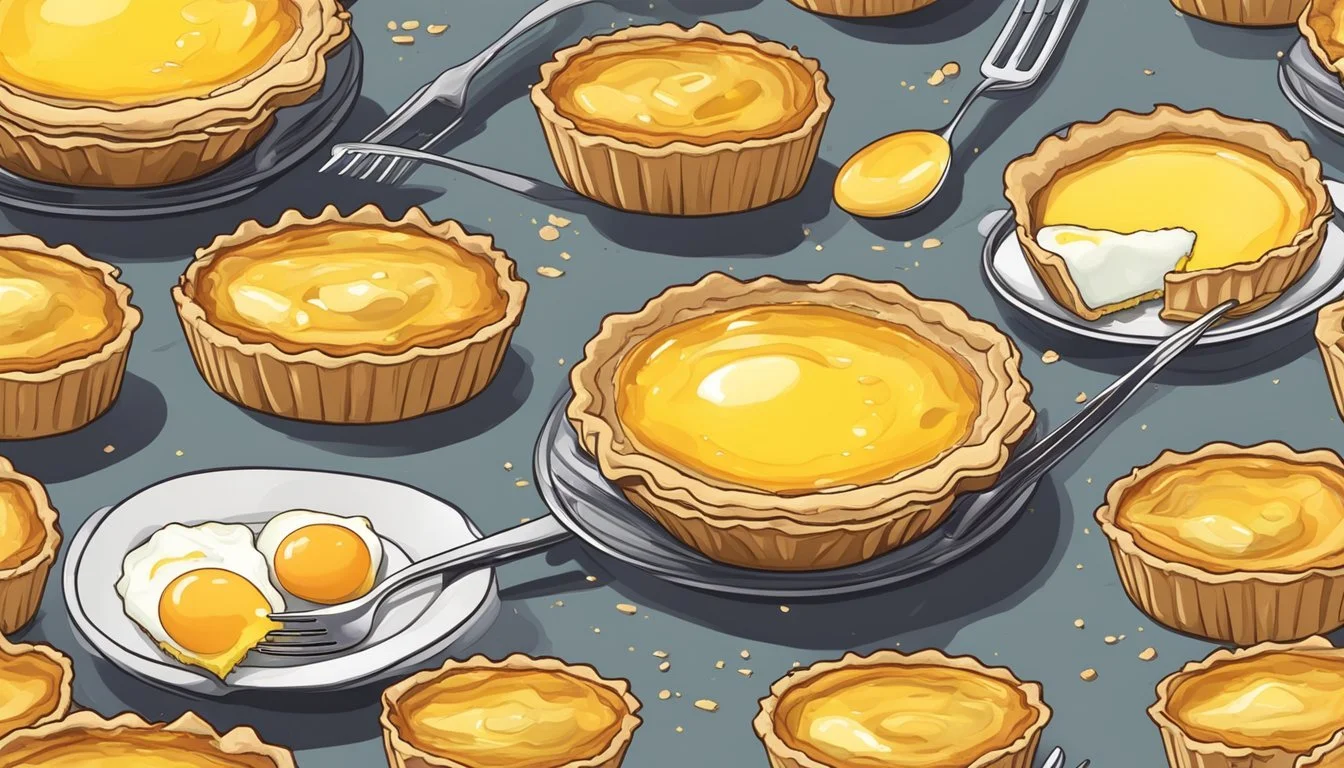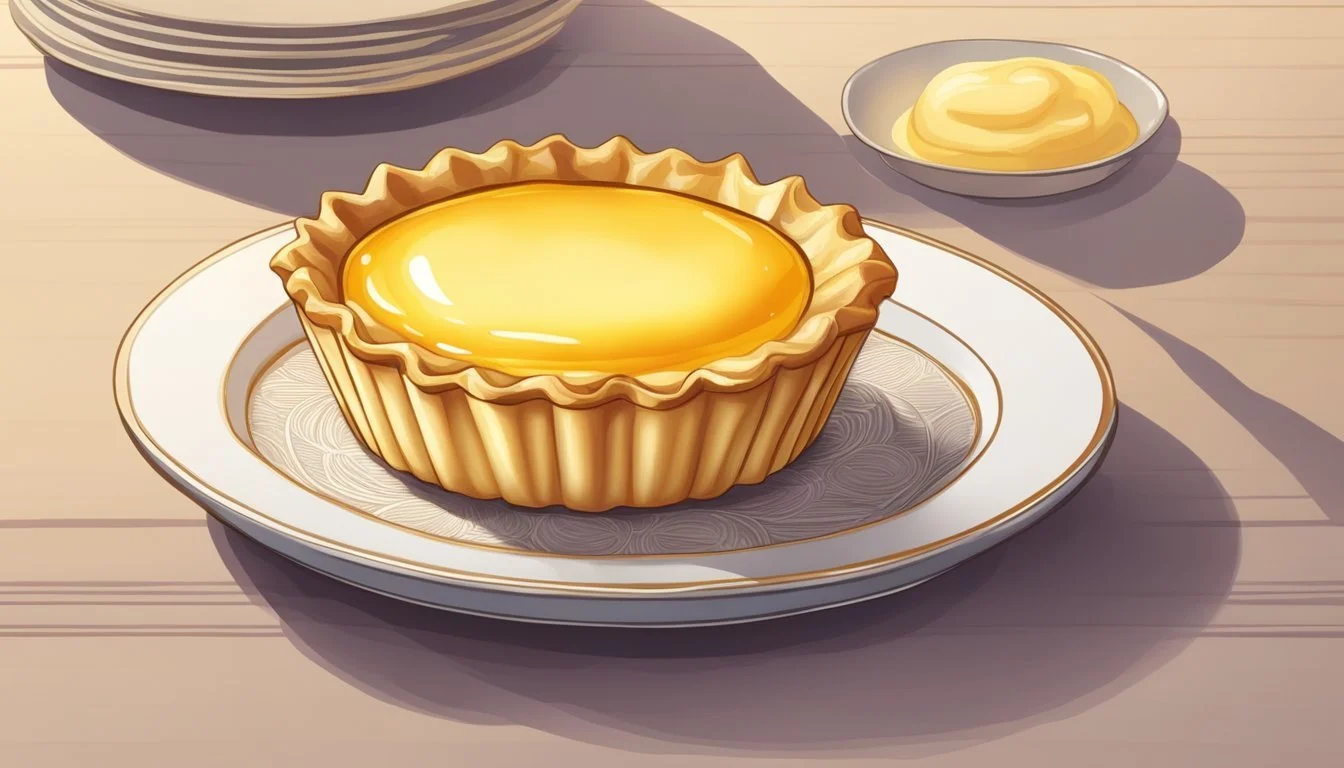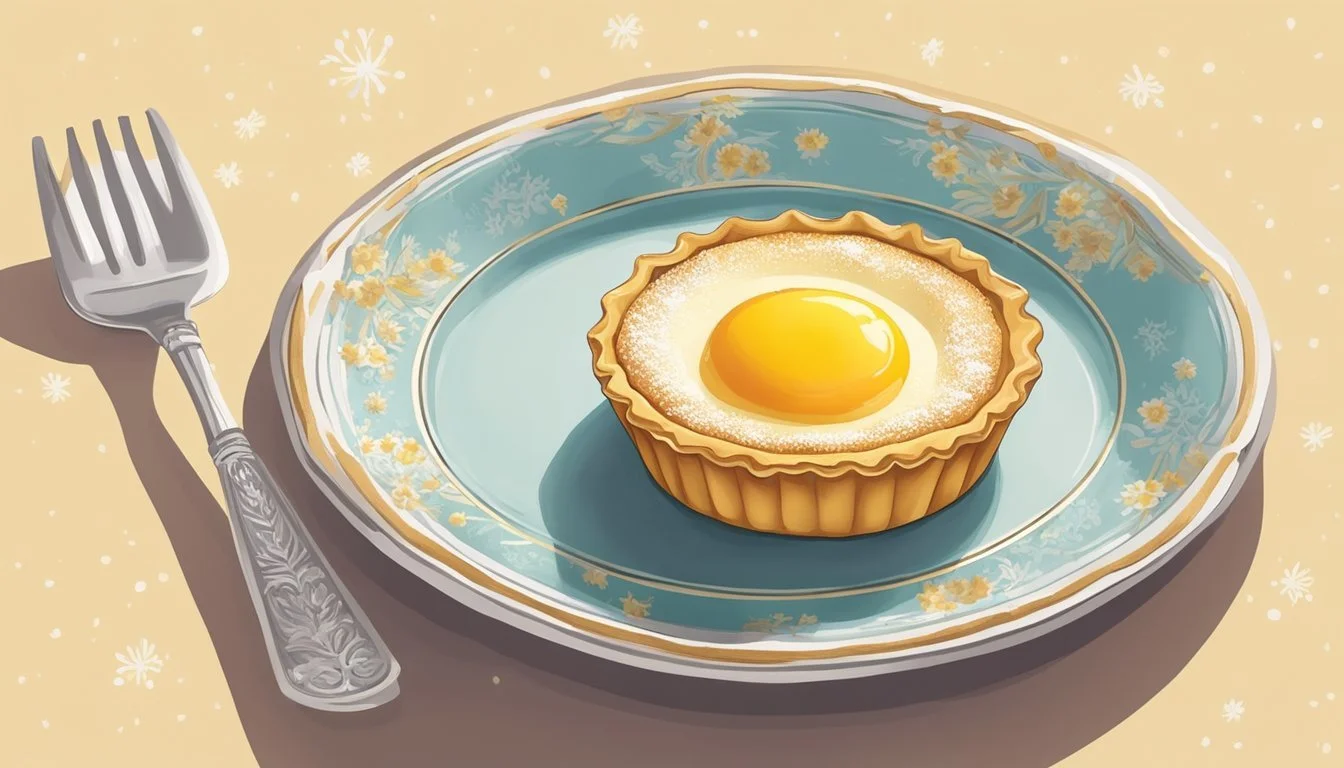How do you eat an egg tart?
Mastering the Art of Enjoying This Delicate Pastry
An egg tart is a delightful pastry, often associated with Chinese and Portuguese cuisine. It begins with a flaky or shortcrust pastry shell that cradles a luscious, set custard (how long do custards last?) made primarily from eggs, sugar, and milk or cream. The filling's texture can range from light and silky to a denser, creamier consistency, depending on the recipe and technique used.
The making of an egg tart might seem daunting, but it can be broken down into approachable steps: preparing the dough, shaping it into tart shells, and creating the custard filling. The pastry is usually creamed together with butter and sugar, then mixed with flour to form a tender base. The custard, meanwhile, is typically a simple whisked mixture of eggs, sugar, and dairy, sometimes enhanced with vanilla for an additional layer of flavor.
What sets egg tarts apart is their glorious versatility when it comes to serving. They can be enjoyed fresh out of the oven or at room temperature, allowing the full depth of their eggy richness to shine. The key is in the balance of a buttery, crisp crust against the soft, smooth custard, making them a truly decadent treat for any occasion.
Understanding Egg Tarts
Egg tarts are a confectionary delight enjoyed across various cultures, each bringing its twist to the recipe, and their nutritional profile can be dissected to understand their impact on diet.
Origins and Varieties
Hong Kong Egg Tarts: These tarts are a classic Cantonese pastry, known as dan tat, and are a staple in Guangzhou and Hong Kong bakeries, especially during Chinese New Year celebrations. They typically feature a buttery, flaky crust paired with a smooth, velvety egg custard.
Macau Egg Tarts: Often called Portuguese egg tarts, they are a variation that originated in Macau, heavily influenced by the pastel de nata from Portugal. This version has a caramelized top and a crust that leans towards a puff pastry style, distinguishing itself from the Hong Kong variant.
Nutritional Information
Serving Size: 1 Tart (Typical)
Nutrients Amount per Serving Calories 200-300 kcal Total Fat 10-20g Saturated Fat 5-10g Cholesterol 50-150 mg Carbohydrates 20-30g Sugars 5-15g Protein 3-5g
It is worth noting that the figures above will vary depending on the size and specific recipe of the egg tart. They are a source of carbohydrates and fats, with sugar and butter being integral components of both the crust and the custard. While they can provide immediate energy, egg tarts should be consumed in moderation within a balanced diet.
Essential Ingredients
The construction of an egg tart relies on a foundation of well-selected ingredients for both its delicate pastry and creamy custard filling. Here's a detailed look at what goes into each component.
Pastry Components
An egg tart's base is essential for its texture and taste. The pastry usually falls into one of two categories: puff pastry or short crust.
Puff Pastry: Traditionally involved is puff pastry, notable for its flaky, light texture. The key components for making puff pastry include:
All-purpose flour: The primary structure of the dough.
Unsalted butter: Provides the necessary fat for the pastry layers.
Water: To help in combining the flour and butter into a dough.
Short Crust: Alternatively, some prefer a short crust, known for its crumbly texture. Ingredients for a basic short crust include:
All-purpose flour: Again, serving as the main ingredient.
Fat: This can be lard, shortening, or unsalted butter, which creates the crumbly texture.
Water: A small amount to help bring the dough together.
Custard Ingredients
The custard center of an egg tart is its signature feature, offering a smooth, rich flavor. The custard mixture typically includes:
Eggs: The core of the custard, offering both structure and color.
Milk or Cream: Milk provides the custard's liquid base, while cream contributes a richer taste.
Sugar: To add sweetness to the custard.
Vanilla extract: Offers a subtle fragrance and enhances the overall flavor.
For variations, some recipes replace milk with evaporated milk for a denser texture, or incorporate additional egg yolks for a deeper yellow color and a creamier custard.
Equipment and Preparation
Before starting, it is crucial for the cook to ensure that they have the right equipment and that all the ingredients are properly prepped. A successful egg tart depends on both meticulous preparation and the use of proper tools.
Cooking Equipment
A well-preheated oven is essential for baking egg tarts to perfection. The cook must ensure the oven is set to the correct temperature, typically between 350°F to 395°F (175°C to 202°C), before the tarts go in. They will need either tart tins or a muffin pan to give the tarts their distinctive shape. The choice between a tin and a pan will depend on the desired final size and shape of the tarts.
Oven (preheated)
Tart tins or Muffin pan
Following the baking process, a wire rack is needed for cooling the tarts to prevent soggy bottoms. Provided the cook works with a fine mesh strainer, they can achieve a silky-smooth custard filling by sifting to remove any lumps.
Wire rack (for cooling)
Fine mesh strainer (for sifting custard)
Mise en Place
Preparation begins with assembling all ingredients, measured accurately with measuring cups. Temperature plays a key role, so ingredients like eggs and butter should be at room temperature unless the recipe specifies otherwise. This is especially important for creating a dough that combines well and a custard that is free of lumps. Some recipes may call for cold ingredients to produce a flaky crust, which must be prepared accordingly.
Key ingredients and temperatures:
Ingredients (measured)
Eggs and butter (room temperature or cold, as needed)
The mise en place ensures a smooth baking process with all elements ready for assembly. This preparation phase sets the foundation for the perfect egg tart.
The Dough Making Process
The creation of the dough is a crucial step in preparing an egg tart as it lays the foundation for the pastry's texture. A well-executed dough results in the desirable flaky and buttery crust that is synonymous with a perfect egg tart.
Creating the Perfect Pastry
For an authentic egg tart, one usually opts for puff pastry dough. This dough is characterized by its layered, flaky texture that comes from a meticulous process of rolling and folding. The process begins with combining flour and water to form a dough. The dough is then smeared with a generous amount of butter, rolled out and folded multiple times. These layers are what give puff pastry its distinctive flakiness.
To start, one mixes a proportioned amount of flour and cold water to create a firm dough that can hold the fat without becoming too elastic.
After mixing, the dough is shaped into a rectangle and chilled briefly, ensuring the butter stays cold to maintain the pastry's structure during baking.
The key to a flaky crust is in the lamination process. Butter is enclosed within the dough and rolled out to create thin layers. This step is repeated several times with chilling in between each fold to keep the butter from melting.
The final step is to carefully roll the dough to the desired thickness, typically a few millimeters, ensuring the pastry is even to provide a consistent pastry crust after baking.
It's imperative to maintain the dough's temperature: too warm, and the butter will melt, too cold, and the dough will crack. Precision and patience in the dough-making process are what yield an egg tart's delicate, flaky puff pastry base.
Preparing the Custard
Crafting the perfect custard for an egg tart involves skillfully balancing sweetness and texture. The custard should be creamy, with a gentle sweetness that complements the egg flavor. A proper custard is central to the overall taste and quality of the tart.
Mixing the Custard
To create the custard for an egg tart, one begins by lightly beating the eggs. To ensure a smooth and lump-free custard, granulated sugar is then incorporated, typically with a whisk, to achieve a homogenous mixture. Gradually, warm milk or cream—often infused with vanilla for an aromatic depth—is added to the egg and sugar combination. Care must be taken to pour slowly and continuously whisk to avoid curdling the eggs, resulting in a silky egg custard mixture. Once combined, the mixture is commonly passed through a sieve to ensure the removal of any clumps, creating an even smoother egg filling.
Consistency and Flavoring
Achieving the right consistency in the custard is crucial; a velvet-like texture that coats the side of a pan suggests that it's reached optimal thickness. Flavorings such as vanilla extract or cinnamon can be added to the custard mixture to enhance its aroma and taste. Sweeteners come in various forms, be it granulated sugar, powdered sugar, or sugar syrup, and their quantity can be adjusted depending on the desired level of sweetness. The aim is a custard that is lightly sweet and deeply creamy, complementing the pastry without overpowering it with sugar. A well-prepared custard is the secret to a flavorful and satisfying egg custard filling.
Assembling and Baking
In preparing egg tarts, one must carefully fill the tart shells with the custard mixture and employ precise baking techniques to ensure a flawless finish. Timing, temperature, and technique are crucial for the perfect custard tart.
Filling the Tart Shells
The tart shells should be filled with the custard mixture up to about three-quarters of their capacity to prevent overflow during the baking process. One could prepare the custard by whisking together ingredients such as eggs, sugar, and hot water until smooth, being certain to dissolve any sugar thoroughly to ensure a consistent filling.
Baking Technique
Preheating the oven is essential, and one should aim to place the tarts near the middle to upper third of the oven for even baking. The ideal baking temperature for egg tarts can vary:
Hong Kong Style Egg Tarts: Typically bake at a higher temperature, around 200 °C (392 °F) for a crisper tart shell.
Custard Tarts: Often bake at a lower temperature, near 180 °C (356 °F) for a gentler, even setting of the custard.
Baking times will also differ, but a toothpick inserted into the center of the tart should come out clean when they are done. After baking, the tarts should be allowed to cool slightly before being enjoyed. This ensures the custard sets properly and also makes them easier to handle.
Serving and Storage
Egg tarts, popular desserts in dim sum culture, as well as beloved treats around the world, require proper serving and storage methods to maintain their delectable taste and texture. The following subsections detail the best practices for serving fresh egg tarts and storing any leftovers to ensure they remain just as enjoyable after their initial bake.
How to Serve
Egg tarts are best served at room temperature or slightly warm. To warm them, one can preheat the oven to 180 degrees Celsius (or 200 degrees Fahrenheit /Gas Mark 6) and heat the tarts briefly. Typically, no more than five to ten minutes is needed. When serving, they can be presented in their pans or removed and placed on a serving platter.
Storing and Reheating Leftovers
For storing leftovers, egg tarts should be kept in an airtight container to maintain freshness. They last approximately two days at room temperature, and for increased shelf life, storing them in the fridge is recommended. When reheating egg tarts, it's advisable to use the oven, microwave, toaster oven, or air fryer to best preserve their texture. If using a microwave, cover the tart and reheat on low power to avoid overcooking. For oven-based appliances, preheat to 180 degrees Celsius (200 degrees Fahrenheit) and warm the tarts until heated through, typically five to ten minutes.
For longer storage, egg tarts can be frozen in a properly sealed container. Defrost in the fridge overnight before reheating as per the instructions above to serve.
Customization and Variations
The adaptability of egg tarts allows for numerous inventive ways to enjoy this delectable snack. From experimenting with toppings to accommodating various dietary needs, these variations can enhance the experience for all palates.
Topping and Flavor Additions
Adding toppings or flavoring to egg tarts can transform them from the traditional Cantonese egg tart into something uniquely personalized. While the classic version has a silky custard and buttery crust, one might:
Sprinkle cinnamon or nutmeg for a warm, spicy note.
Introduce fruit such as berries or a light layer of fruit preserves on top of the custard for a sweet and tart contrast.
Swirl vanilla bean extract into the custard mixture before baking to elevate the creamy flavor.
Experiment with mini tarts as bite-sized versions which can be topped with an assortment of fruits and flavors.
For those who are adventurous, infusing the custard with citrus zests can add a new dimension of flavor, paying homage to the Portuguese custard tarts, which are known for their slightly caramelized exteriors and rich, egg custard centers.
Alternative Dietary Options
Egg tart lovers with dietary restrictions can also enjoy this traditional dish with several adjustments to the classic recipe that do not compromise on its tender texture and delicious taste:
Gluten-Free Crusts: By using gluten-free flour alternatives like almond or coconut flour, one can create tart shells that are suitable for those avoiding gluten.
For a Macau-style influence, which typically includes a layer of coconut, an alternative can be to use coconut milk in the custard for those who are lactose-intolerant.
The custard base offers flexibility for reducing sugar or using sugar substitutes to cater to those monitoring their sugar intake.
Vegan versions of egg tarts can be achieved by substituting eggs and dairy with ingredients like silken tofu for the custard and using a vegan pastry crust.
It's important to note that modifications may affect the final texture and flavor, yet they provide enjoyable options for nearly everyone.
Final Touches
When serving an egg tart, attention to detail can elevate the experience. The final touches are where presentation meets the culmination of baking craftsmanship.
Presentation
Before presenting an egg tart, one ideally ensures that it has cooled sufficiently to set the custard. A light, even dusting of powdered sugar adds a layer of sweetness and visually enhances the treat's appeal. Careful not to overload the surface, a sprinkling of powdered sugar should be just enough to complement the tart without overshadowing its delicate flavors.
Tips and Tricks
When enjoying an egg tart, the key to maximizing pleasure lies in paying close attention to the consistency and texture of the pastry. Fine-tuning these elements can significantly enhance the eating experience.
Consistency and Texture
An egg tart's joyful consumption hinges on achieving a balance between a crispy and crunchy crust, and the smooth, soft custard center. One should aim for a custard that is cooked to the point where it still wobbles slightly but is not runny. It is crucial for the tart to be enjoyed at the right temperature. Ideally, egg tarts should be served warm. If one has stored them in the refrigerator, reheat them in an oven preheated to 350°F (175°C) for about 5 minutes to revive the crust's crunch without overheating the custard.
Troubleshooting Common Issues
At times, tarts may emerge from the oven with a less than ideal texture. Here are some adjustments one can make:
Soggy Bottom: This often occurs when the oven temperature is too low. To avert this, ensure that the oven is adequately preheated to around 395°F (202°C) before baking.
Overcooked Custard: If the custard becomes grainy and overcooked, it is crucial to check the oven temperature and reduce the cooking time. A fan-assisted oven may require a lower temperature setting, approximately 356°F (180°C).
Uneven Baking: To avoid unevenly baked tarts, one must place them on a rack near the middle to upper third of the oven. Regularly rotating the pan halfway through baking can also promote an even bake.
Crispiness: For a homemade tart to achieve optimal crispiness in the crust, one might need to add a brief period of high heat, possibly closer to 400°F, at the beginning or end of baking.
By remaining vigilant about these details, one ensures that their egg tart experience remains consistently delightful.












